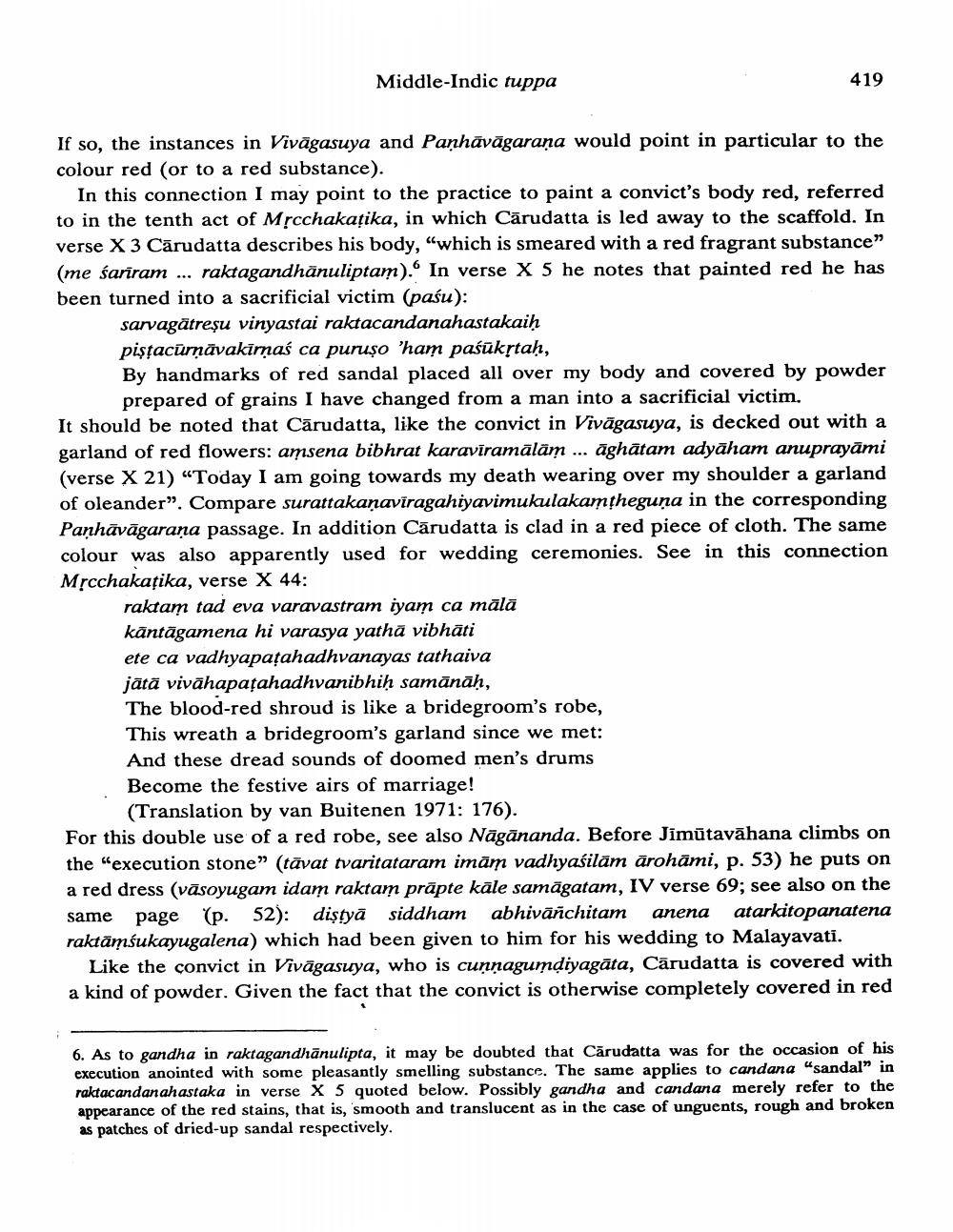________________
Middle-Indic tuppa
419
If so, the instances in Vivāgasuya and Panhāvāgarana would point in particular to the colour red (or to a red substance).
In this connection I may point to the practice to paint a convict's body red, referred to in the tenth act of Mșcchakațika, in which Cārudatta is led away to the scaffold. In verse X 3 Cārudatta describes his body, “which is smeared with a red fragrant substance" (me sariram ... raktagandhānuliptam). In verse X 5 he notes that painted red he has been turned into a sacrificial victim (pašu):
sarvagātreșu vinyastai raktacandanahastakaiḥ piştacūrņāvakīrņaś ca puruṣo 'ham paśūkstaḥ, By handmarks of red sandal placed all over my body and covered by powder
prepared of grains I have changed from a man into a sacrificial victim. It should be noted that Cărudatta, like the convict in Vivāgasuya, is decked out with a garland of red flowers: amsena bibhrat karavīramālām ... āghātam adyāham anuprayāmi (verse X 21) “Today I am going towards my death wearing over my shoulder a garland of oleander”. Compare surattakanaviragahiyavimukulakamtheguņa in the corresponding Paṇhāvāgarana passage. In addition Cārudatta is clad in a red piece of cloth. The same colour was also apparently used for wedding ceremonies. See in this connection Mrcchakațika, verse X 44:
raktam tad eva varavastram iyam ca mālā kāntāgamena hi varasya yathä vibhāti ete ca vadhyapațahadhvanayas tathaiva jātā vivāhapatahadhvanibhiḥ samānāḥ, The blood-red shroud is like a bridegroom's robe, This wreath a bridegroom's garland since we met: And these dread sounds of doomed men's drums Become the festive airs of marriage!
(Translation by van Buitenen 1971: 176). For this double use of a red robe, see also Nāgānanda. Before Jimūtavāhana climbs on the "execution stone” (tāvat tvaritataram imām vadhyaśilām ārohāmi, p. 53) he puts on a red dress (vāsoyugam idam raktam prāpte kāle samāgatam, IV verse 69; see also on the same page (p. 52): distyā siddham abhivāñchitam anena atarkitopanatena raktāmśukayugalena) which had been given to him for his wedding to Malayavati.
Like the convict in Vivāgasuya, who is cuņņagumdiyagāta, Cārudatta is covered with a kind of powder. Given the fact that the convict is otherwise completely covered in red
6. As to gandha in raktagandhānulipta, it may be doubted that Cārudatta was for the occasion of his execution anointed with some pleasantly smelling substance. The same applies to candana "sandal" in raktacandanahastaka in verse X 5 quoted below. Possibly gandha and candana merely refer to the appearance of the red stains, that is, smooth and translucent as in the case of unguents, rough and broken as patches of dried-up sandal respectively,




